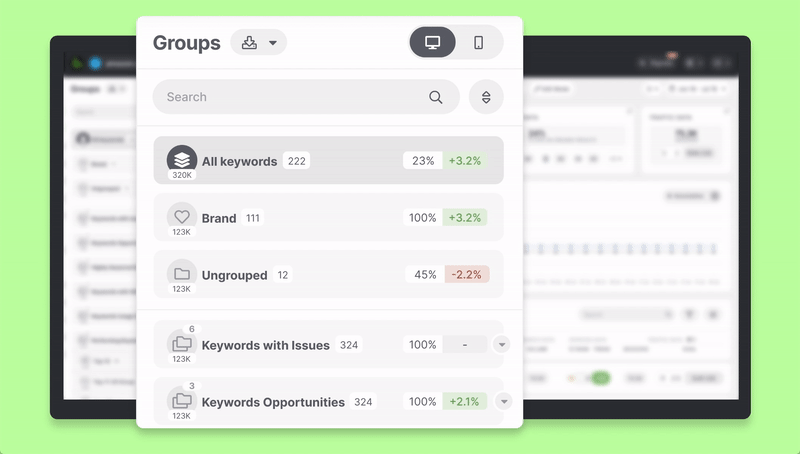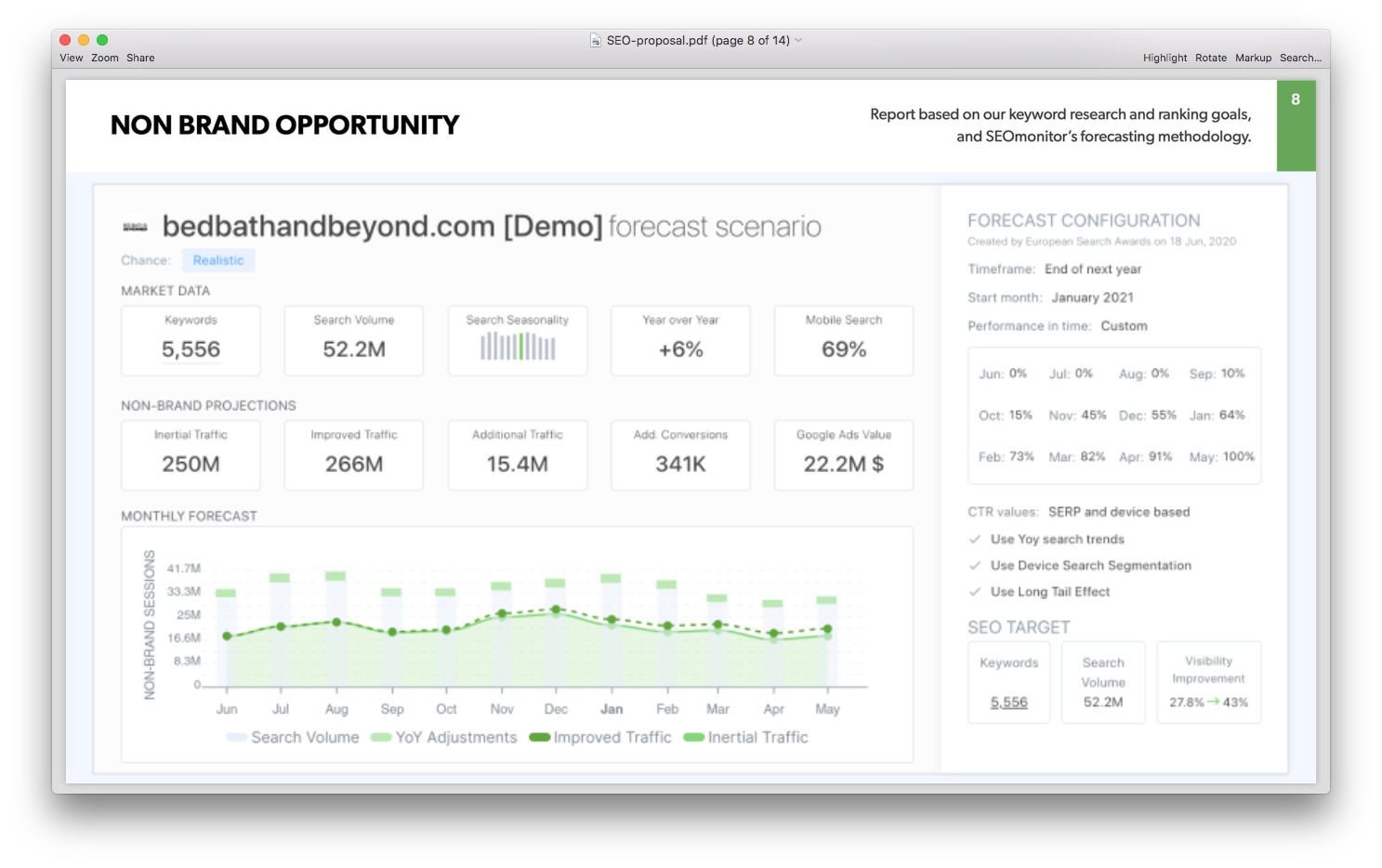2020 has been the year of uncertainty. Strategies changed overnight and clients’ budgets were no longer stable, which called for new approaches.
“How much should we invest?” is one of the questions that became critical. It’s one you’ll still have to tackle as CMOs are pressed to make the most out of shrinking marketing budgets.
To help your clients get back on track or manage growth in their vertical, you can create multiple business scenarios – from prosperity to hardship. That way, you’ll paint the bigger picture while taking into account all possible routes.
Forecasting is not about trying to predict the future, but about identifying “the full range of possibilities, not a limited set of illusory certainties,” as Paul Saffo argues in his Six Rules for Effective Forecasting.
For forecasting to work, you need a reliable data model.
So let’s see how you can approach forecasting business scenarios using your SEO agency know-how and particular strength – a plethora of search data at your fingertips.
How to Approach Forecasting Business Scenarios
What Is Your Cone of Plausibility?
In his HBR article mentioned above, Saffo talks about mapping a “cone of uncertainty” – a strategic map that allows you to “delineate possibilities that extend out from a particular moment or event.”
This “map” needs a specific breadth and a strict understanding of variables and the relationships between them.
As he further explains, if you need to evaluate possible scenarios for hybrid cars in the late 1990s, you’ll take into account factors such as oil price trends, consumer preferences in cars, the emergence of competing technologies, but also outliers such as perturbations in the Middle East and a crash in oil.

This, actually, ties into a long-standing tool for forecasting – the cone of plausibility as conceived by Charles Taylor in 1988 and further developed by Hancock & Bezold (1994) – which helps you navigate potential futures in terms of their probability or preferability, depending on your status quo and underlining opportunities:
- The probable future is the one that can occur if current trends continue without any intervention or changing factors.
- The preferable future is the one where trends continue, but you also intervene inside that “cone” of opportunities.
In this model, both probable and preferable are part of possible scenarios.
When it comes to business scenarios, it means defining the benchmark before everything else so as to know how to allocate budgets, create stocks and prepare for growth in certain areas.
What Is a Scenario in This Case?
When it comes to business scenarios, it means defining your benchmark before everything else so as to know how to allocate budgets, create stocks, and prepare for growth in certain areas.
The business scenario involves your objectives and how to go about them within expected or potential limits.
To help create business scenarios, SEO scenarios imply choosing the right inputs to delineate areas of maintenance, areas of potential growth, or where demand might shift, based on your client’s current search status.
Then, to connect the business and SEO scenarios, this can be your “playground” for building reliable estimations:
- In-depth keyword research, so your SEO team knows which keyword groups to tackle for which scenarios.
- A current Visibility status as the starting point.
- A business financial assessment – is there a tendency to grow, maintain the status quo, or even scale?
Set the Right Expectations from the Start
Speak Business
Whether you’re calibrating an existing strategy or tackling a new client, you need a reliable benchmark to set your scenarios against. That’s where the search Visibility metric comes in handy.
Think of it as a way to establish “market share” for your client against online competitors – calculated as an impression share on their targeted keywords weighted against search volume, it will highlight who the true competitors are when looking at non-brand organic traffic and where there’s room to grow for your client.
It highlights a probable future if you take into consideration all the factors influencing the current visibility.
Let’s say your client is part of a highly competitive market – you know that the main competitor is at 75% Visibility, which means that your intervention on high potential keywords will have a significant impact on business results. Sometimes even when you’re tackling a difficult demand context like 2020, such as was the case for Propellernet and their travel client.
In order to do that, you need to be really careful about how you select the keyword lists for your top-level strategic themes.
Develop Business Scenarios
You want to connect SEO scenarios and potential business results, so you need to establish how specific keywords and costs to reach a certain performance for those keywords correlate.
Maintaining Steady Business Results
If your client needs to secure their current business position, then you can focus on those keywords that are already performing and take into account what factors will influence them:
- What their current search volume is and how it will look like as influenced by search seasonality and year-over-year trends.
- How their performance in time can look like on desktop versus mobile.
- The additional traffic they can bring if there’s still room for growth from top 10 to top 3, for instance – thus the additional traffic received if they reach their best ranks.
Your keyword management strategy will play a major part here, as you’ll want to keep a close eye on specific keyword groups representing those top performers, categorized by:
- Page 1 keywords
- Specific product categories
- Landing pages
- Seasonal
- Keyword opportunities – maybe you can set a part of the budget for some new keyword targets.
You can generate multiple scenarios within this maintenance objective, with various possibilities:
- The probable one – focusing to maintain the top performers as is, thus having an estimated inertial traffic figure – calculated as the total number of visits estimated to be received through the duration of the forecast, based on the current traffic and the search trends and granted that there would be no changes in the site’s visibility.
- The preferred one – a mixed strategy of focusing on maintaining top 3 performance for a set of keywords and achieving better ranks for various keywords with an “easy” difficulty level.
For instance, if your client is in the home improvement industry and their offering on “pools” is booked until the end of the next year or the next 2 years, you’d want to mainly do maintenance work and prepare for seasonality with additional high-intent keywords to keep the trend going.
Optimizing Specific Keyword Groups for Growth
If your client wants to invest more of the marketing budget in SEO in the near future, then you can think about how to use it in the best possible way – the preferable scenario in this case.
You can aim for low-hanging fruit, whether underrated keywords that are not that costly or opportunities that are easy to achieve, which resulted from your competitors’ analysis. Look for solutions to keep you within the budget and have a high chance to add to the probable future.
For instance, using the competition insights feature in your SEO tool, you can spot a set of top keywords that are high in value and low in difficulty for your client.
You’ll be able to estimate the CPC equivalent and make the case for optimizing the client’s landing pages, so as to obtain impact in a cost-effective way and outrank the competitors.
Let’s take a challenging example of a travel client.
Although traffic is mostly down, you know that “spring break 2021” will bring an uptick. So how do you help your clients prepare in order to capture most of that traffic? Or maybe it’s local travel that you should optimize for and move into “preferable growth” territory.
In SEOmonitor’s forecasting module, you can calculate the additional conversions your optimized keyword list can generate, as follows:
- We’ve researched the average CTR curve for the top 10 positions on each individual combination of SERP features and devices.
- We base the estimation of the additional conversions on the estimated additional visits (if you reach the targeted ranks) multiplied by the corresponding conversion rate of each keyword included in the forecast.
Thus, you’ll be able to correlate how achieving the ranks for your targeted keywords directly impacts the client’s sales.
Managing an Exploding Trend for the Client’s Business
If your client is part of an “exploding” trend, having business areas that are growing by default due to high demand, you can think about how to make that extra budget work for underperforming parts of the business and leverage the hype.
You can also question the status of that trend – is it here to stay? Will it be part of your probable future scenario? If yes, then you’ll know when it’s due to peak and how to prepare for it – both SEO wise and stocks and business availability wise.
Then, moving onto the preferred scenario of growth in other areas, your keyword research might focus on “moderate” and “hard” difficulty keywords and improving rankings for relevant keywords (high volume ones) on Page 2 of Google. Tackling the more costly keywords where the competition is hard will prove beneficial for business impact while having keywords jump from Page 2 to Page 1 will dramatically alter conversions.
Model these estimations in time and present to your clients how their traffic can look with and without those improvements.
You can also think about preparing a scenario for demand shifting again – which means helping the client maintain rankings after the momentum passes.
For example, let’s say your client in the home and decor industry is in the top 3 for “office chair” or “desk”, but there are good keyword opportunities for “desk organizer” or “standing desk” as well. Model your forecast based on how you can maintain their advantage with keyword alternatives resulted from popular search queries.
In the case of the travel industry client, it might imply creating both seasonality keyword groups and keyword groups that you’re aiming to move into top 3 concerning “domestic travel”, “domestic flights”, “staycations” etc. as a preferred outcome.
With SEOmonitor’s forecasting tool, you can create multiple SEO scenarios for the same keyword groups, looking to see how inertial traffic and additional traffic can look in the next 6, 9, or 12 months.
Make the Case for Your SEO Proposal
Once you’ve created the SEO scenarios and budgets in accordance with business scenarios, you’ll still need to present it to your clients. Whether it’s a newly acquired client or a new proposal for a long-standing client, you have to explain why you’re recommending a strategy or another.
It’s a good moment to explain once more how your SEO intervention influences ROI, by highlighting:
- Your deep knowledge of their industry and how granular you approached keyword research.
- Competitor overview in terms of Visibility and where the client can grow.
- The SEO opportunities they can leverage.
- The multiple scenarios you’ve forecasted and your estimates in terms of traffic, CTR, and additional conversions.
Talking to award-winning agencies from around the world, we’ve uncovered that a converting SEO proposal usually contains these arguments and some more. You can get access to some of their business case presentations here.
In a Nutshell
It has been a challenging year for business in general.
That’s why setting the right expectations for your SEO clients can go a long way both from a strategic point of view and as a trust-building outcome:
- Help them navigate uncertainty and establish a reliable benchmark for their current business status.
- Use search visibility as a form of “market share” that sheds light on your clients versus their competitors and where there’s room for improvements.
- Develop SEO scenarios in accordance with their growth objectives and current business status: maintaining the status quo in terms of rankings, growing a specific part of their business, and helping them identify opportunities, or managing an “exploding” trend with a strategic focus on new areas of improvement.
- Create an SEO proposal that highlights the ROI of SEO – from the general overview all throughout the nuts and bolts of keyword groups and their conversion potential.
At SEOmonitor, we’re constantly improving our forecasting methodology to answer SEO agencies’ needs. With a set of complex inputs including the current non-brand organic traffic, custom CTR curves, search seasonality, etc., we’re able to estimate how sessions and conversions can look if the desired ranks are reached within the forecasted timeframe. Plus, for the sake of transparency, you can see all the calculations at a keyword level, in our platform.
And to make it easier to communicate, we’ve also designed a proposal builder that leverages your forecasted data from SEOmonitor and transforms it into good-looking Google slides through a simple drag and drop interface.
These are just a part of our solutions to help SEO agencies acquire, manage, and retain more customers.
Join us in our journey to bring more transparency to the SEO industry.
Create business scenarios
with a reliable SEO forecasting tool!
The opinions expressed in this article are the sponsor's own.






